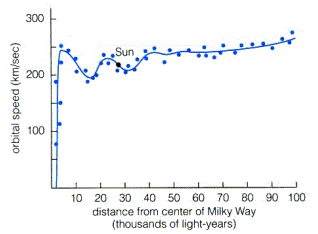Dark matter... really? C'mon!
A project for students who, like me, didn't buy the typical explanation of dark matter in undergraduate classes.
When first presented with the idea of 'dark matter' in one of my undergraduate astronomy classes, the explanation seemed hollow. How could the majority of the mass that makes up our galaxy be some unknown substance that no one can see or touch? That just seemed too ridiculous. To make matters worse, the main source of proof typically shown is a small graph of the rotation curve of the Milky Way Galaxy (Kutner, Pg. 301). A similar one is shown below.
[6]
According to this graph, dark matter must clearly exist because the line becomes essentially flat at large distances from the galactic center. However, according to Kepler's Law, the rotation curve should drop off at a rate proportional to the inverse of the radius.
This of course is intuitively obvious to even the most casual observer, right? Yeah, I didn't think so either. The next few pages should explain not only the rotation curve, how it is found, and what it tells us, but, will also make a rotation curve from the motions of stars in our galaxy. In the end, it should put forth a convincing argument for dark matter in the Milky Way Galaxy, as well as the rest of the universe.
